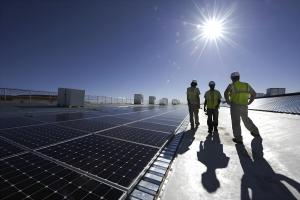
Global Photovoltaic Installed Capacity Expected to Reach 520GW in 2024
S&P Global forecast: global PV installed capacity is expected to reach 520GW in 2024, and global PV module shipments will exceed 600GW.
LOS ANGELES, UNITED STATES, August 30, 2024 /EINPresswire.com/ -- At the recently concluded 3rd China Photovoltaic Green Supply Chain Conference, S&P Global's Chief Analyst, Hu Dan, predicted that global photovoltaic (PV) installed capacity is expected to reach 520GW in 2024, with global PV module shipments exceeding 600GW.
The analyst stated that the global PV market's installed capacity is expected to be 520GW in 2024, with China contributing the largest share, possibly reaching 240GW. The Southeast Asian PV market is experiencing stable growth. Australia’s annual grid-connected capacity is about 5GW, Japan's is between 4-5GW, and South Korea’s exceeds 3GW. The pace of large-scale ground-mounted PV plants in the Middle East is accelerating, with increasing installations in markets like Saudi Arabia, and the Middle East market is expected to reach 16GW in 2024. The U.S. is projected to have an installed PV capacity of nearly 50GW in 2024, while Europe's PV market will approach 100GW, with a high proportion of distributed demand. Currently, Africa's PV market is mainly concentrated in South Africa, with a market space exceeding 10GW, and an annual energy storage demand of nearly 3GWh. It is expected that more than 1.5GWh will be grid-connected in the second half of 2024.
From 2024 to 2026, the construction of PV capacity in regions such as Europe, the United States, and India will drive massive demand for equipment, with the total market size expected to reach 30.4 billion yuan. The demand for silicon wafer, cell, and module equipment is expected to reach 6.9 billion, 11.3 billion, and 4.2 billion yuan, respectively.
(Source: https://cj.sina.com.cn/articles/view/2169901267/815610d300101679u)
Photovoltaic Power Generation in China
In the first half of 2024, China added 102.48GW of new photovoltaic (PV) capacity, marking a 31% year-on-year increase. Of this, 49.6GW was from centralized PV installations, and 52.88GW from distributed PV installations.
As of the end of June 2024, the total grid-connected PV capacity in China reached 712.93GW, including 403.42GW from centralized PV power plants and 309.51GW from distributed PV systems, which includes 131.84GW from residential PV.
China's PV industry is characterized by a high degree of industrial chain completeness, significant scale effects, and leading technological capabilities. The total PV installation capacity for the year is expected to exceed 240GW. Additionally, the proportion of PV power generation in the total power generation is also increasing, with an expected rise to 9% for the full year.
Photovoltaic Power Generation in the United States
According to the latest report from the U.S. Energy Information Administration (EIA), in the first half of 2024, photovoltaic power accounted for 59% of all newly added power generation, making it the primary driver of electricity growth in the United States.
The total new installed capacity for all large-scale ground-mounted technologies in the first half of the year was 20.2GW, an increase of 3.6GW compared to the same period last year. The EIA expects that the new installed capacity in the second half of 2024 will reach 42.6GW, with large-scale ground-mounted PV contributing 25GW.
By the end of 2024, the newly added PV installed capacity is expected to reach 37GW, setting a new record for single-year installed capacity and doubling the 18.8GW achieved in 2023. The EIA's estimate is only 1GW different from the forecasts made earlier this year by the Solar Energy Industries Association (SEIA) and Wood Mackenzie. However, the latter's forecast considers all solar market segments, including residential, community solar, and commercial and industrial sectors, rather than focusing solely on large-scale ground-mounted projects.
The biggest variable for the U.S. PV industry is changes in import policies. Beginning June 6, high anti-circumvention tariffs will be imposed on modules and cells imported into the U.S. from four Southeast Asian countries. This policy is expected to significantly impact future installations in the U.S.
Photovoltaic Power Generation in Europe
As of the end of 2023, Europe had a cumulative installed PV capacity of 263GW, approaching the 2025 installation target. Looking solely at the 2024 installation situation, on the one hand, the reduction in traditional energy costs may dampen installation enthusiasm, while on the other hand, some regions are experiencing slow progress in power plant approvals, leading to a slowdown in overall installation growth.
In 2024, Germany is expected to account for 19% of the PV module demand in Europe, ranking first among individual country markets. Poland, Italy, the Netherlands, and Spain follow in positions 2 to 5, with each accounting for 7-8%, collectively making up about 50% of the total European market demand.
Even though the European market this year is influenced by factors such as the decline in traditional energy prices, supply chain price drops, financing cost considerations, and subsidy reductions, limiting the growth in module demand, long-term demand is expected to grow. This is due to the EU's continued favorable policies for renewable energy development and the collective consensus among member states to achieve the 2030 net-zero carbon targets. The demand for PV modules in the European market is expected to be between 95.1GW and 111.3GW in 2025, reflecting a 9-18% growth compared to this year.
Challenges Facing the Photovoltaic Industry
It is worth noting that despite the rapid development of the photovoltaic (PV) industry, it also faces significant challenges. The dramatic fluctuations in raw material prices have put pressure on many companies, with polysilicon and silicon wafer prices falling by more than 40%, and the prices of cells and modules dropping by over 15% in the first half of the year. Additionally, the PV industry is subject to stringent requirements for ESG (Environmental, Social, and Governance) development.
Overall, the first half of this year has seen a continuous rise in global geopolitical conflict risks, accelerating the deep restructuring of industrial and supply chains. Many major global economies remain under tight monetary policies, increasing uncertainties in economic growth. While the energy structures of various countries are rapidly transitioning towards green and low-carbon models, global PV terminal installations continue to rise, though at a slower pace.
In the face of these challenges, PV companies need to respond proactively, continuously enhancing their competitiveness through technological innovation, industrial upgrades, and ESG information disclosure.
Solar Cable Market Analysis
The downstream segment of the PV industry chain includes power generation and applications, such as PV power systems, grid transmission, PV application products, and Building-Integrated Photovoltaics (BIPV). As essential electrical components in this industry chain, the demand for photovoltaic cables is set to see significant growth in line with the development of the PV industry.
According to the Renewable Energy Association, a 1MW photovoltaic power plant typically requires about 12 kilometers of PV direct current (DC) cables. Consequently, global demand for cables in PV power plants is expected to be 5.76 million, 6.6 million, and 7.26 million kilometers in 2024, 2025, and 2026, respectively, with year-on-year growth rates of 26%, 15%, and 10%.
ZMS analysts believe that the rapid growth of the new energy storage market will drive a substantial increase in demand for cables. As a specialized cable manufacturer, ZMS plans to expand its production lines for special cables to better meet the growing demand for various new energy-specific cables.
To adapt to this trend, ZMS will not only enhance production efficiency and product quality but also strengthen technological research and development to launch products that better meet market demands. Additionally, the company will closely monitor changes in international standards and trends in technological innovation to ensure that the cables for solar system it produces meet the evolving needs of the industry, particularly in terms of weather resistance, fire performance, and transmission efficiency, thereby maintaining a leading position in the highly competitive market.
ZMS Cable
ZMS Cable
+ +86 37167829333
email us here
Visit us on social media:
Facebook
X
LinkedIn
YouTube
Distribution channels: Building & Construction Industry, Energy Industry, Environment, Manufacturing, World & Regional
Legal Disclaimer:
EIN Presswire provides this news content "as is" without warranty of any kind. We do not accept any responsibility or liability for the accuracy, content, images, videos, licenses, completeness, legality, or reliability of the information contained in this article. If you have any complaints or copyright issues related to this article, kindly contact the author above.
Submit your press release




